Across a Deadly Field “Gettysburg – A Long Afternoon”
Played at the “Little Wars” Chicago Convention, April 26, 2014
After Action Report – By Patrick R. LeBeau and Dean West
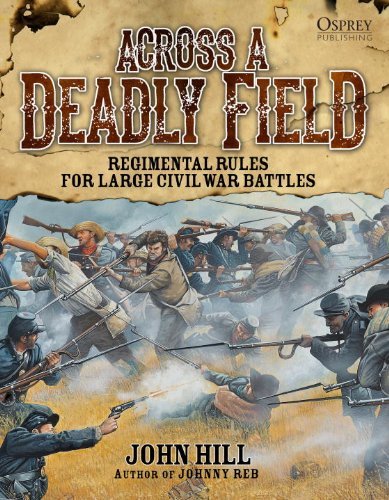
The Scenario – The scenario covers the first day of Gettysburg starting at 2:00PM in the afternoon, one hour before the arrival of Early’s and Pender’s Confederate divisions. The positions are historically where they were, with the exception that it is assumed that Slocum’s XII Corps, instead of waiting over three hours at Two Taverns, sends the first division of the XII Corps to the sound of the guns to assist General Howard and the hard pressed XI Corps. The purpose of this scenario was to see if one extra Union division – that could easily have been there — would have made a difference on the critical first day of Gettysburg.
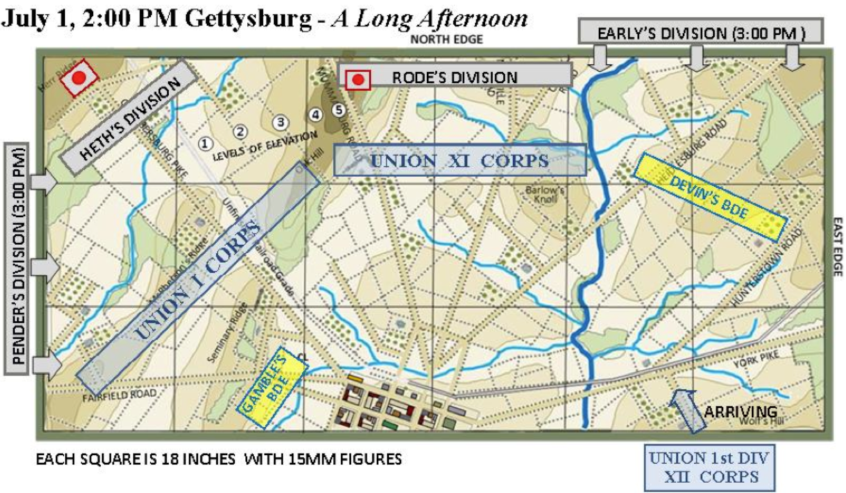
map of the battlefield
The Game at Little Wars: The First Afternoon of Gettysburg
The players were 13 gamers with a mix of veteran Johnny Reb players along with more than a few first timers. However, at times a casual observer would have been hard pressed to tell the vets from the newbies. The rules were John Hill’s soon to be published Across a Deadly Field (ADF) by Osprey Publishing. The units were regiments and batteries and each turn represented one half hour of real time with an approximate ground scale for 15mm figures of one inch equals 80 to 100 yards. The game, with 200 individual units, had reached a clear conclusion after six hours of play. This scenario will be included in the first ADF scenario book scheduled for publication in November of this year. The ADF rulebook itself will be released this summer, at Historicon and is currently on preorder from Amazon. The gamemasters for this battle were Patrick R. LeBeau and Dean West, with additional assistance from Kermit Hilles.
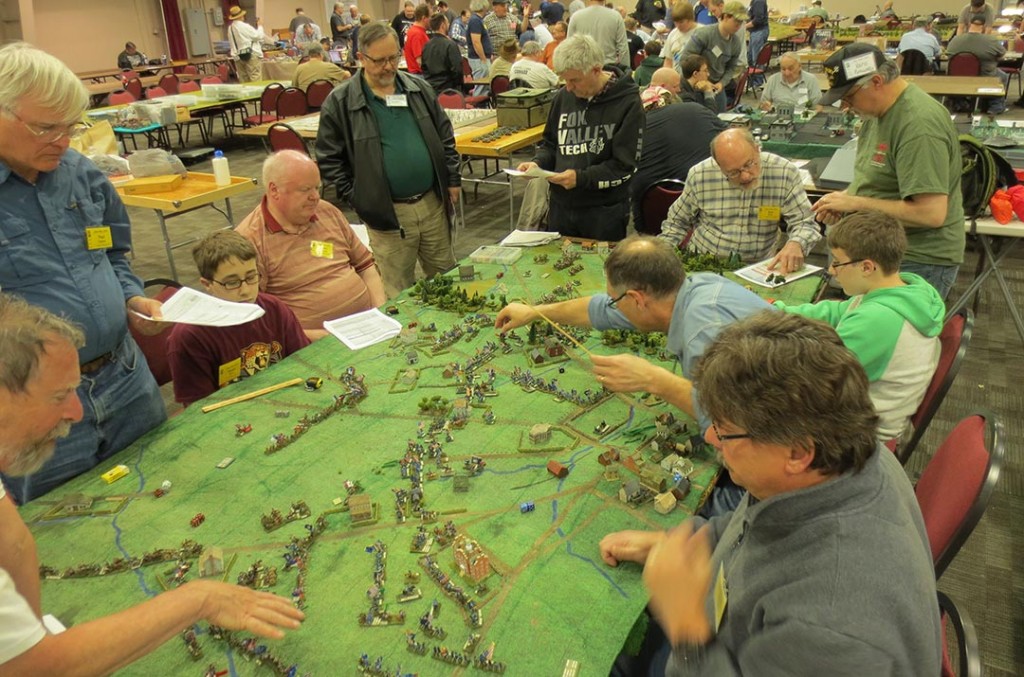
The Long Afternoon Begins…
The battle began on the northwestern flank, as two CSA artillery battalions of A.P. Hill’s Corps unleashed a heavy barrage on the defending Union First Corps which was deployed in the artillery’s normal range. Although the cannonade had some significant effect in the opening turns, the CSA infantry attacks pressed the Union lines back and out of effective range of CSA artillery by turn three. In an unexpected consequence, the early success of the CSA artillery imprinted an out-of-proportion reliance on artillery over infantry and as a result more than a few of the Rebel commanders would spend more time maneuvering artillery, rather than pressing forward with aggressive infantry attacks. This, in turn, would slow the tempo of their attack and often gave the Union much needed time between the Rebel assaults to rally shaken troops and to adjust for breaks in their lines.
On the northeastern field with the arrival of Early’s Confederate division, the battle started with a rush of brigade movement and very little firepower. Devin’s cavalry brigade, deployed to hinder and delay Early, wisely decided to retreat to the vicinity of the Heidlesburg Road bridge over Rock Creek and took up defensive positions along the creek’s western bank. Meanwhile, McDougall’s brigade from William’s First Division of Slocum’s XII Corps had marched to take up defensive positions around the Toll House and Shaffer’s farm between the Gettysburg & Hanover Railroad and the York Pike. McDougall was soon reinforced by XII Corps artillery and the combined forces were clearly setting up a blocking force for the remaining two brigades of William’s division to march to the center of the battlefield to reinforce General Howard’s XI Corps – which proved to be a courageous and decisive decision. This left only McDougall’s Brigade, XII Corps Artillery and Devin’s cavalry brigade to confront Early’s then arriving powerful division and they spent much of those first two turns disguising their intentions and preparing to receive “Old Jubal”.
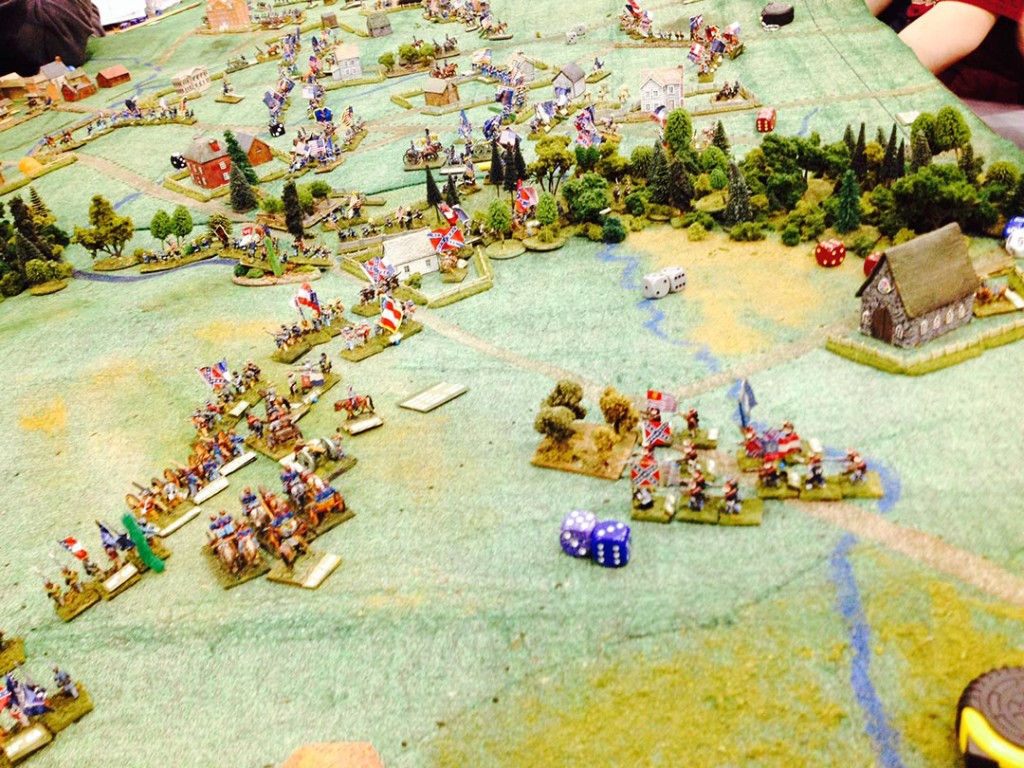
Early’s division floods towards a thin blue line holding the Union right flank along Rock Creek.
— Photo: Patrick R. LeBeau
For a turn or two, Early did not discern the actual intent of the XII Corps Unionists and was confused by the slow and then fast retreat of the cavalry. Consequently, Early remained east of the Rock Creek the entire game and never successfully punched through to the center field. At first, Early pressed McDougall’s Brigade with the presumed hope of overwhelming the elements of the reduced XII Corps piecemeal. However, Early halted and deployed only to see Union troops retreating. But, now time, distance and Early’s cautious advance allowed the XII Corps plan of action to take shape. At one point, Early decided to aggressively attack Devin but one brave cavalry battalion’s lucky shot – a most excellent Union die roll followed by a really bad Confederate morale roll – halted an almost “for certain” successful charge of Early’s grayclad infantry. Then, in the nick of time, elements of Ruger’s brigade of XII Corps arrived to stiffen the line and Devin’s cavalry safely retreated behind a new Union line.
Meanwhile as Pender’s Division arrived on the western edge of the battlefield, it formed an intimidating continuous line that would drive the Federals back to Seminary Ridge. Anchoring the line, the famed Iron Brigade was particularly hard pressed and Gamble’s dismounted cavalry brigade was charged and swept from the field in a series of very aggressive brigade charges. The thought of buoyant success filled the hearts and minds of Pender’s troops, only to be dashed with the failure of Heth’s division, deployed on Pender’s left, to aggressively support the Confederate advance. Heth, however, had wasted his division’s combat effectiveness in numerous rash piecemeal charges into the heart of well-disciplined Union troops defending good ground and reinforced by a second, and in some places, a second and third line. Most of Heth’s charges and attacks were tardy and poorly positioned due to his commanders wanting artillery in place to fire onto targeted Union lines before the charges. This, of course forced the infantry to stand at a distance to allow for lanes of fire and overhead shots. Henry Heth – as did his historical namesake – would not have a good day.
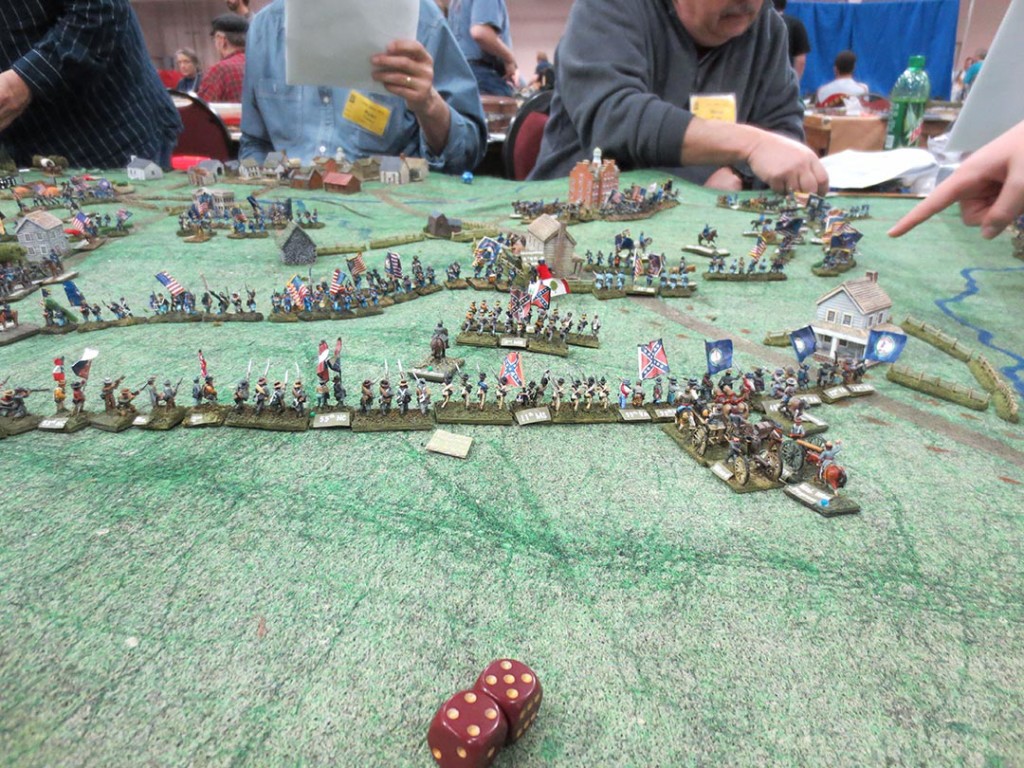
Pender’s Division squares off against the Union First Corps on McPherson’s Ridge as Union reserves gather around the Lutheran Seminary. Photo by Patrick R. LeBeau
On the northern front, however, Rodes’ division marched on, with good form and supported lines and attacked with vigor and precision against the “Dutchmen” of XI Corps and Barlow’s division reeled back from the assault. One odd maneuver, however, was that Rodes moved a brigade over to the east side of Rock Creek, which did allow for an effective enveloping attack on Barlow’s Knoll but at the cost of time, which was becoming an important consideration as the “just in time” elements of the XII Corps began to arrive to support Howard’s shaky “Dutchmen” exactly when and where it was needed.
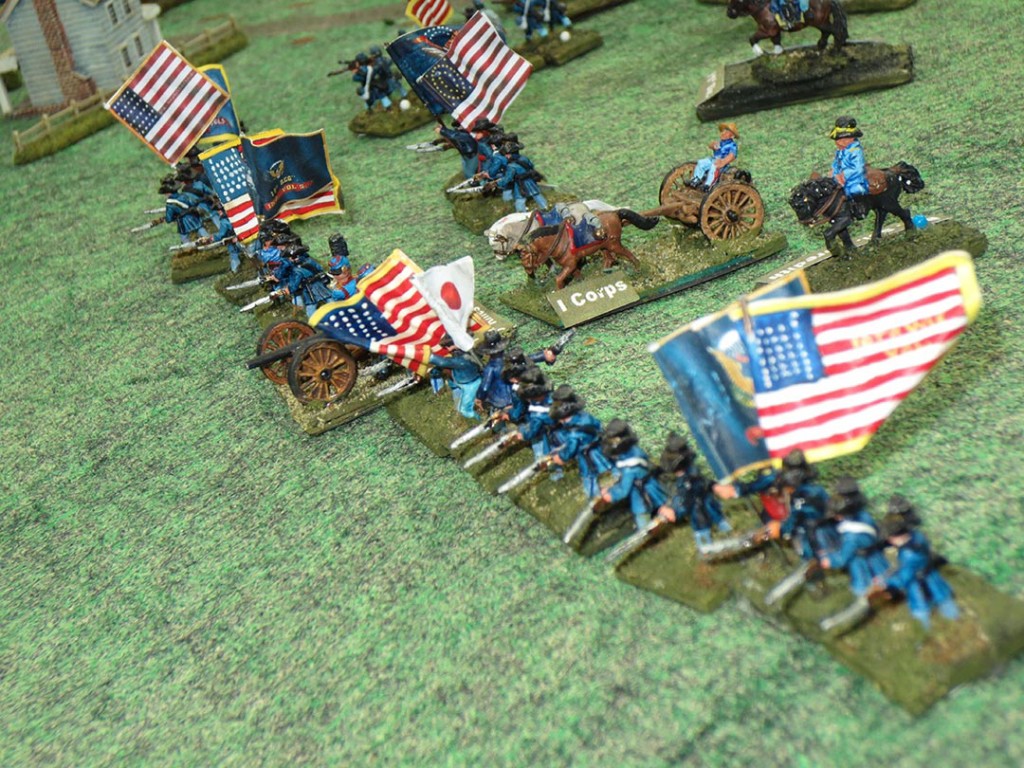
The Iron Brigade stands ready to hold McPherson’s Ridge. Photo by Patrick R. LeBeau
Despite a very bad defensive position and with his flanks heavily threatened, the XI Corps commander fought a very technical and brilliant defense. Though Barlow was knocked of his famous Knoll, a few well timed counter charges forced Rodes to back pedal and regroup. More importantly, due to the time it took Rodes to take the Knoll combined with the subsequent counter attacks that interrupted his forward progress; the Rebs could not recover fast enough to take ground before the arrival of the second and third brigades of XII Corps’ First Division. Finally, the Confederate attack crested just north of the town of Gettysburg, giving the Union – thanks to the timely dispatch of the two brigades of Williams’ division of XII Corps to the Union center – a well-earned and hard fought tactical victory.
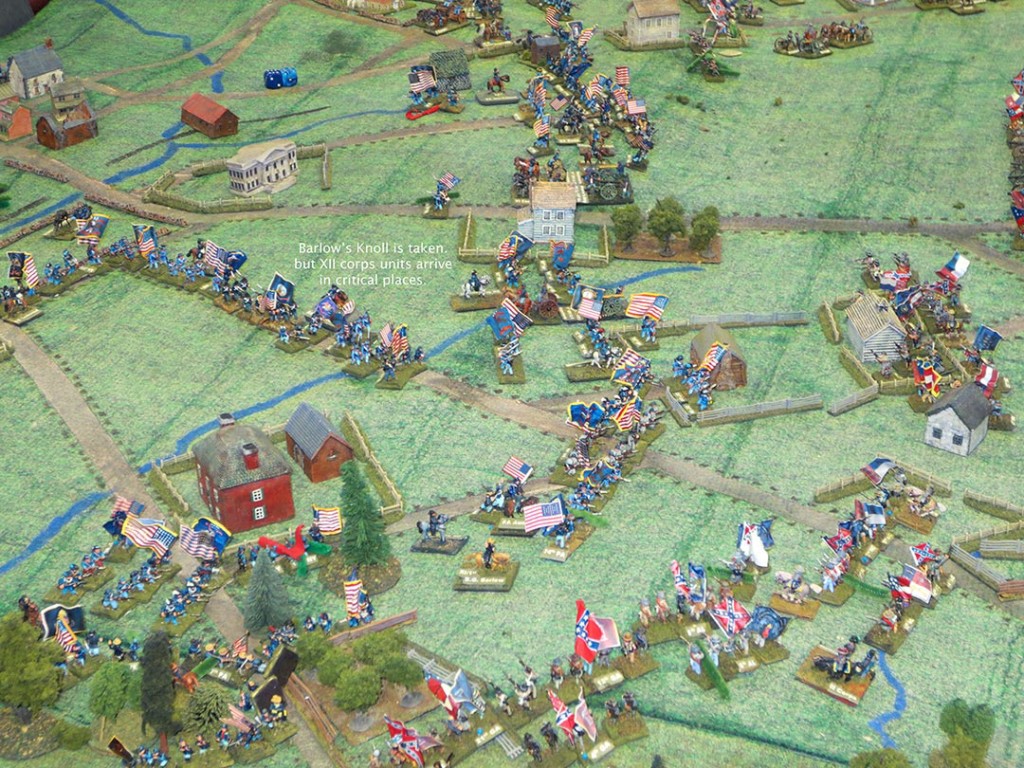
As the Union is roughly pushed off Barlow’s Knoll, the XII Corps units arrive just in time to shore up the Union line. — Photo by Patrick R. LeBeau
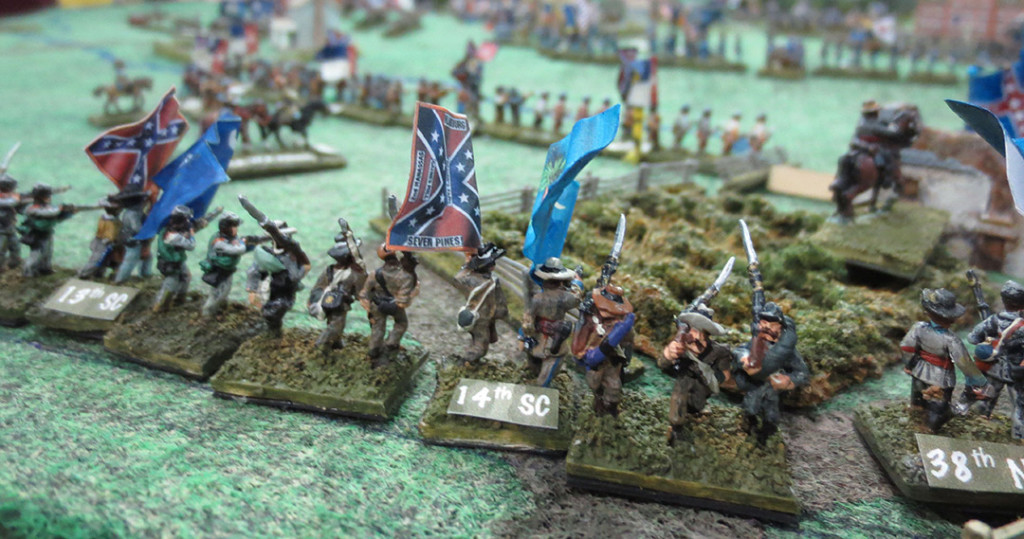
Perrin’s South Carolina Brigade forms up, as it historically did, to attack Seminary Ridge – though one battalion does seem to be having second thoughts and may be headed for the rear.
– Photo by Patrick R. LeBeau
Gamemaster’s Observations
As for game play, we were surprised at the ability of gamers to read and play the charts by the second turn and played the game without much help until a charge or unique situation emerged.
Although we had been playtesting John Hill’s “First Day of Gettysburg “ ADF scenarios since last summer, we were unsure how gamers familiar with John’s Johnny Reb would react and mix with those that were not. And to do this, while simultaneously trying to grasp the mechanics of a new game system for the first time, along with some new, first time young gamers in a large and complex scenario. How would each group respond? Well, we were astounded at the ability of gamers to read and play the charts by the second turn and played the game without much help until a charge or complex situation emerged and despite 13 different players of varying age and experience, pushing over 200 individual units, we had a firm decision after six hours of play. That, in our opinion, spoke well for the playability and clarity of these new rules. Also, at one point in the game, the Confederates were able to form a contiguous line all the way from the northeast edge of the battlefield to the west edge which really looked like so many of the period paintings of the actual civil war battles – talk about a great historical feel!
Patrick, Dean and John Hill himself will be running this scenario again at NashCon in Tennessee on the weekend of May 23-25, and again at JohnnyCon in Indianapolis on June 6-8 and, of course, at Historicon in July — with the terrain getting better and more detailed at each event. In addition, at NashCon, Cory Ring, another member of the ADF team, will be moderating an ADF scenario based on Shiloh’s East Flank on Friday afternoon using his gorgeous 28mm figures. And for those that would like a smaller game – ADF also works fine for those — Dean will be presenting his subtly nuanced Battle of Piedmont scenario that Sunday morning at NashCon. So, ya’all come on down to NashCon for some good old fashioned southern hospitality and gaming!
Thanks and good gaming!
If you like this article you should read our other “Across A Deadly Field” posts at this link
*** Across A Deadly Field is available for pre-order by clicking on the Amazon link further up the page. Clicking on our ads and affiliate links help to support Cigar Box Battle! And, we also encourage you to support the digital magazine ACW Gamer (banner ad up and to your left). It is an amazing resource, full of great ACW content and we know you’ll love it!

4 responses to “Across a Deadly Field Gettysburg at Little Wars AAR”
If you are going for most excellent contents like
me, simply pay a visit this site every day since it gives quality contents, thanks
When I initially left a comment I seem to have clicked
on the -Notify me when new comments are added- checkbox and from now on every time a comment is added I receive four emails with the exact same comment.
Perhaps there is a way you can remove me from that service?
Many thanks!
Hello
YOU NEED QUALITY VISITORS FOR YOUR: cigarboxbattle.com ?
WE PROVIDE HIGH-QUALITY VISITORS WITH:
– 100% safe for your site
– real visitors with unique IPs. No bots, proxies, or datacenters
– visitors from Search Engine (by keyword)
– visitors from Social Media Sites (referrals)
– visitors from any country you want (USA/UK/CA/EU…)
– very low bounce rate
– very long visit duration
– multiple pages visited
– tractable in google analytics
– custom URL tracking provided
– boost ranking in SERP, SEO, profit from CPM
CLAIM YOUR 24 HOURS FREE TEST HERE=> ventfara@mail.com
Thanks, Josefina Fredricksen
Great web site.Much thanks once more. Want additional. Walker Kohara
http://movingcompanies56555.blogoscience.com